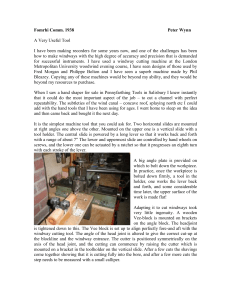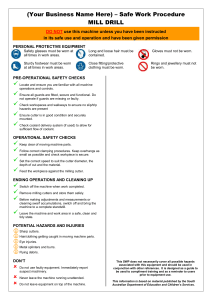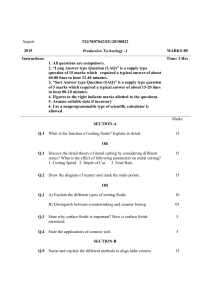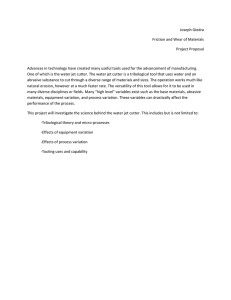Tool Length & Surface Roughness in End Milling
advertisement
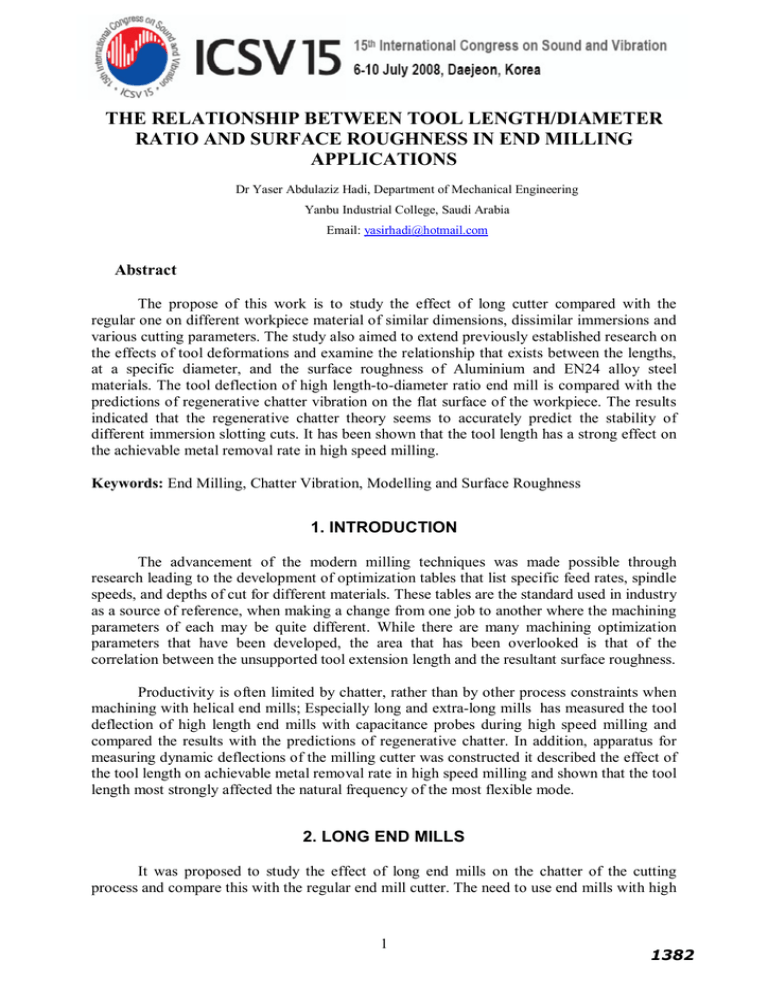
ICSV15. 6-10 July 2008. Daejeon. Korea
THE RELATIONSHIP BETWEEN TOOL LENGTH/DIAMETER
RATIO AND SURFACE ROUGHNESS IN END MILLING
APPLICATIONS
Dr Yaser Abdulaziz Hadi, Department of Mechanical Engineering
Yanbu Industrial College, Saudi Arabia
Email: yasirhadi@hotmail.com
Abstract
The propose of this work is to study the effect of long cutter compared with the
regular one on different workpiece material of similar dimensions, dissimilar immersions and
various cutting parameters. The study also aimed to extend previously established research on
the effects of tool deformations and examine the relationship that exists between the lengths,
at a specific diameter, and the surface roughness of Aluminium and EN24 alloy steel
materials. The tool deflection of high length-to-diameter ratio end mill is compared with the
predictions of regenerative chatter vibration on the flat surface of the workpiece. The results
indicated that the regenerative chatter theory seems to accurately predict the stability of
different immersion slotting cuts. It has been shown that the tool length has a strong effect on
the achievable metal removal rate in high speed milling.
Keywords: End Milling, Chatter Vibration, Modelling and Surface Roughness
1. INTRODUCTION
The advancement of the modern milling techniques was made possible through
research leading to the development of optimization tables that list specific feed rates, spindle
speeds, and depths of cut for different materials. These tables are the standard used in industry
as a source of reference, when making a change from one job to another where the machining
parameters of each may be quite different. While there are many machining optimization
parameters that have been developed, the area that has been overlooked is that of the
correlation between the unsupported tool extension length and the resultant surface roughness.
Productivity is often limited by chatter, rather than by other process constraints when
machining with helical end mills; Especially long and extra-long mills has measured the tool
deflection of high length end mills with capacitance probes during high speed milling and
compared the results with the predictions of regenerative chatter. In addition, apparatus for
measuring dynamic deflections of the milling cutter was constructed it described the effect of
the tool length on achievable metal removal rate in high speed milling and shown that the tool
length most strongly affected the natural frequency of the most flexible mode.
2. LONG END MILLS
It was proposed to study the effect of long end mills on the chatter of the cutting
process and compare this with the regular end mill cutter. The need to use end mills with high
1
1382
ICSV15. 6-10 July 2008. Daejeon. Korea
length to diameter ratios is unavoidable, such tools are required for the production. The
selection of the appropriate tool length in conjunction with high speed machining can
dramatically improve the metal removal rate and to reduce chatter. Chatter is one of the most
significant limitation in increasing metal removal rate in milling . The appropriate selection of
the cutting parameters in end milling are based on the SME standard . In particular, the
technique described in this work includes selecting the spindle speed to take advantage of the
chatter occurrence for different immersions and then studies the most effect parameters which
assist in occurrence chatter.
It is possible to change the natural frequency of the system by increasing or decreasing
the tool length. In general, as the length of the tool increases, the effective tool mass
increases, the stiffness decreases and the natural frequency decrease. The stiffness of the
cutting tool (k)-if we consider it as a cantilever beam- is inversely proportional to the cube of
the length.
k=
3EI
l3
(1)
Where E is Young’s modulus, which depends on the material of the cutter, I is the second
moment of area of the cross section, and l is the cutter length. The effective mass would
increase in direction proportion to the length. The second moment of area I of the cylindrical
πd 4
I
=
bar can be calculated from the equation.
.where d is the cutter diameter. The
64
fundamental natural frequency fn would decrease in proportion to the square of the length of
the cutter, where the natural vibration occurs under the action of restoring forces inherent in
an elastic system . From equation 1, the natural frequency in relation with the cutter length is
shown in equation 2.
fn = 0.06d 2
E
E
= 0.06d 2 4
l m
l ρ
(2)
3
Where ρ is the mass per unit length.
The fundamental natural frequency would increase in proportion to the tool length-diameter
ratio (figure 1). Several experiments were performed on different cases (two teeth regular
cutter, four teeth regular cutter and four teeth long cutter) to predict the relationship between
tool length and the chatter vibration through the natural frequency. The systems parameters
for the model are shown in table 1.
The cutting tests demonstrate changes of 10 and 20 mm diameter end mill in cutting the
carbon steel, EN24 alloy steel and aluminium by increasing its length from 83.5 mm to 122
mm (approximately 6:1 length to diameter ratio). Therefore, the range of cutting tool lengths
for each test identified different end mill immersions.
2
1383
ICSV15. 6-10 July 2008. Daejeon. Korea
Table 1 Parameters of the machine tool for the simulation model
Stiffness for each mode
Damping ratio for each mode
Natural frequency
Diam.(d),mm Mass(m) kg
10 (2-teeth,
Regular)
20 (4-teeth,
Regular)
20 (4-teeth,
Long)
Moment of
Inertia(I),mm4
Kx= ky= 7e7 (N/mm)
ζ=0.02
f= 487 Hz, 10mm diam., Regular
f= 1539 Hz, 20mm diam, Regular
f= 606 Hz, 20mm diam., Long
Modulus of
Damping
Length(l), mm elasticity(E),
Coefficient(c)
N/mm2
N/m/s
4.11
490.8739
66.5
3.36831E+ 12
678.4689
4.127
7853.982
83.5
1.06691E+ 14
679.8706
4.185
7853.982
122
3.32772E+ 14
684.6313
Cutting Force Coefficients
C T = 661.9
Aluminium
C R = 0.2039
C T = 1648
Steel
C R = 0.3409
WT = 0.2068
W R = 0.297
WT = 0.2188
W R = 0.088
2500
Natural Frequency (Hz)
2000
1500
1000
500
0
Length/Diameter (l/d)
Figure 1. Illustration of the natural frequency from equation 2 to l/d ratio
3. DYNAMIC DEFLECTION MODEL
The cutting force acting on the cutter will excite the spindle vibration . Theoretically,
it is assumed that the transfer function between the cutting force on the cutter and the
vibration spindle is linear and has a single degree of freedom with mass, damping ratio and
natural frequency. For simplicity of presentation, spindle system with a single degree of
freedom, the displacement and acceleration in the X and Y direction may be expressed
{Elbestawi, 1994}, as follows:
3
1384
ICSV15. 6-10 July 2008. Daejeon. Korea
F − cx& i − kxi
m
= x& i + &x&i +1dt
= xi + x&i +1dt
(3)
F − cy& i − kyi
m
= y& i + &x&i +1dt
= xi + x&i +1dt
(4)
&x&i +1 =
x& i +1
xi +1
And
&y&i +1 =
y& i +1
yi +1
Where &x& and &y& are acceleration of X and Y directions, x& and y& are velocities of X and Y
directions, x and y are the displacement of X and Y directions, dt is the integration time
interval and i index of time increment for integration.
The radial deflection of the spindle is due to the F R component of the cutting force,
this causes an error in the chip thickness h, which is equal to the deflection of spindle nose XS.
XS =
FR
KS
(5)
Equation 5 becomes:
FT = K T Ad (h −
FR
)
KS
(6)
Thus, the instantaneous chip thickness for any particular increment is affected by spindle
deflection. The cutting process parameters were determined from a series of cutting tests,
where the cutting forces components (F X and F Y) can be measured directly by using a force
dynamometer. In milling operation, as one of teeth is cut, the next tooth following the cut will
have a bigger chip load (feed per tooth) in order to remove the material left by the previous
cut. Therefore, the influence of a cut on the cutting force can be simulated as the cut tooth
with a smaller chip load and the following one with a bigger chip load. Tables 2 and 3 show
the simulations signals of displacement with a cut tooth on the cutter. The spindle speeds are
chosen as for the detection of the chatter signal model, therefore it will be 10 and 20 (rev/s).
The first column displays the displacement of x signals and the second one for y.
The computer program will follow the rotation of the cutter (SPR) in 240 steps/rev for
4-teeth or 120 for 2-teeth. The cutter rotating angle between each step (SRA). SPR=
Rd
−1
− 0 , assuming the
360/240= 1.5o or 3o. For the angle of engagement (θE-θS) of cos 1 −
R
o
start angle equals zero and that succeed the angle to be 60 for half immersion and 41.41o for
quarter immersion. The total steps per tooth period of 90o is 60/1.5= 40 and 26.61 for the half
and quarter immersion respectively, for 20 mm cutter diameter. The model runs for 1000
steps that is, 1000/240= 4.17 revolutions. During several initial tooth periods, vibrations start
to develop and then reach the steady state.
4
1385
ICSV15. 6-10 July 2008. Daejeon. Korea
4. PARAMETERS FOR SIMULATION
Here the above-mentioned simulation method is used to investigate the chatter in
milling process. The parameters used in the simulation are listed in table 3, which contains the
parameters of machine tool. The width of the workpiece is in the directional normal to the
feed direction, the value of which is varied to obtain a different workplace's fundamental
natural frequencies to investigate the influence of workpiece on dynamic behaviour. In the
simulation the spindle speeds applied are 10 and 20 (rev/s) and the delay times between two
subsequent cuts Td are 0.025 and 0.0125 seconds. The axial depth of cuts at spindles 10 and
20 are 0.1 and 0.21 for aluminium material and 0.27 and 0.56 mm for EN24 alloy steel
respectively.
The model being used in the simulation is a regenerative force . Regenerative force
means that the force on any tooth in the cut depends not only on the feed per tooth and
deflection of the cutter, but also on the surface, which was left by the way of the previous
teeth. The dynamic information about the cutter is contained in the multiple degrees of
freedom, each of two perpendicular directions in the plane of the cut. The simulation runs in a
series of small time steps and at each instant the cutter is rotated and the forces on each tooth
involved in the cut are computed.
(A)
(B)
Long cutter, quarter and half
immersion and Aluminium
material.
Short cutter, quarter and half
immersion and Aluminium
material.
(C)
(D)
Short cutter, quarter and half
immersion and EN24 alloy steel
material
Long cutter, quarter and half
immersion and EN24 alloy steel
material
Figure 2. Effect of long and short end mill cutter on the surface finish of EN24 alloy steel and
aluminium with different immersions
5
1386
ICSV15. 6-10 July 2008. Daejeon. Korea
Table 2. Simulated plots for the displacement in X and Y direction with straight teeth cutters for EN24
alloy steel material
case
n
f
Rd Simulation displacement in X-mode
(rev/sec) (mm/sec) (mm)
(mm)
Simulation displacement in X-mode
(mm)
-5
8
-5
x 10
1
10
1
5
2
4
0
2
-2
0
-4
-2
-6
-4
0
0.05
0.1
0.15
0.2
0.25
-8
0
-5
4
x 10
4
6
0.05
0.1
0.15
0.2
0.25
0.05
0.1
0.15
0.2
0.25
0.05
0.1
0.15
0.2
0.25
0.05
0.1
0.15
0.2
0.25
-5
x 10
x 10
3
2
2
20
1
2
1
0
-1
5
0
-2
-2
0
0.05
0.1
0.15
0.2
0.25
-3
0
-4
2
-4
x 10
1
1.5
x 10
0.5
1
3
10
2
5
0
0.5
-0.5
0
-1
-0.5
-1
0
0.05
0.1
0.15
0.2
0.25
-1.5
0
-5
8
-5
x 10
4
6
4
20
2
5
x 10
2
4
0
2
-2
0
-4
-2
-6
-4
0
0.05
0.1
0.15
0.2
0.25
-8
0
-5
8
-5
x 10
5
x 10
6
0
4
5
10
1
10
-5
2
-10
0
-2
0
0.05
0.1
0.15
0.2
0.25
-15
0
-5
4
4
3
6
20
1
10
0
1
-2
0
0.05
0.1
0.15
0.2
0.25
-6
0
-5
2
10
2
0.25
0.05
0.1
0.15
0.2
0.25
0.05
0.1
0.15
0.2
0.25
0.05
0.1
0.15
0.2
0.25
x 10
1
10
0
5
-1
0
-2
-5
0
0.05
0.1
0.15
0.2
0.25
-3
0
-5
8
0.2
-4
x 10
15
10
0.15
-4
-1
0
7
0.1
x 10
2
2
20
0.05
-5
x 10
-5
x 10
5
x 10
6
0
8
20
2
10
4
-5
2
-10
0
-2
0
0.05
0.1
0.15
6
0.2
0.25
-15
0
1387
ICSV15. 6-10 July 2008. Daejeon. Korea
Table 3. Simulated plots for the displacement in X and Y direction with straight teeth cutters for
aluminium material
case
n
f
Rd Simulation displacement in X-mode Simulation displacement in X-mode
(rev/sec) (mm/sec) (mm)
(mm)
(mm)
-5
2.5
-5
x 10
x 10
2
2
1.5
1
10
1
5
0
1
0.5
-2
0
-0.5
-1
0
0.05
0.1
0.15
0.2
0.25
-4
0
-6
10
0.05
0.1
0.15
0.2
0.25
0.05
0.1
0.15
0.2
0.25
0.2
0.25
-5
x 10
x 10
1
0.5
5
0
2
20
1
5
-0.5
0
-1
-5
0
0.05
0.1
0.15
0.2
0.25
-1.5
0
-5
6
-5
x 10
4
3
10
2
5
x 10
2
4
0
2
-2
0
-4
-2
-6
-4
0
0.05
0.1
0.15
0.2
0.25
-8
0
0.05
0.1
0.15
-5
-5
2.5
2
x 10
x 10
2
1.5
4
20
2
5
0
1
0.5
-2
0
-0.5
-1
0
0.05
0.1
0.15
0.2
0.25
-4
0
2.5
4
2
10
1
10
0.1
0.15
0.2
0.25
0.05
0.1
0.15
0.2
0.25
0.05
0.1
0.15
0.2
0.25
0.15
0.2
0.25
x 10
2
1.5
5
0.05
-5
-5
x 10
0
1
-2
0.5
-4
0
-0.5
0
0.05
0.1
0.15
0.2
0.25
-6
0
-6
12
-5
x 10
1
10
x 10
0.5
8
0
6
20
1
10
6
-0.5
4
-1
2
-1.5
0
-2
0
0.05
0.1
0.15
0.2
0.25
-2
0
-5
6
7
10
2
10
-5
x 10
5
4
0
2
-5
0
-10
-2
0
0.05
0.1
0.15
0.2
0.25
x 10
4
20
2
10
0.05
0.1
x 10
2
2
1.5
8
-15
0
-5
-5
2.5
x 10
0
1
-2
0.5
-4
0
-0.5
0
0.05
0.1
0.15
7
0.2
0.25
-6
0
0.05
0.1
0.15
0.2
0.25
1388
ICSV15. 6-10 July 2008. Daejeon. Korea
5. CONCLUSION
1. This study looks at the relationship of different workpiece materials in varying cutting
tool lengths. The results validate the original premise of unequal surface roughness in
some regions of workpiece cuts.
2. The simulation models illustrated in tables 2 and 3 show significant differences in
plots for the displacement in X and Y directions with straight teeth cutters for EN24
alloy steel and aluminium materials of 10 and 20 mm diameters.
3. The effect of long and short end mill cutters on the surface roughness at workpiece of
four alternative end mill cuts are displayed in figure 2. The ratio of 1:2 cutting tool
lengths and immersions produced superior surface roughness for the workpiece
materials at different cutting tool lengths.
4. This work used a wide range of workpiece materials, cutting tool lengths and
diameters with different immersions. Comprehensive data compiled to develop a
series of displacement charts which can be used to eliminate an element of setup waste
related to end milling operations within the manufacturing industry.
5. This study has addressed an area that has been neglected and the initial research has
been conducted for this specific topic, surface roughness equivalences of the
relationship between tool length/diameter ratio in end milling applications.
6. This effort included studies the following:
• Different cutting tool length/diameter ratios
• Different workpiece materials
• Different cutting immersions
• Large sample sizes
REFERENCES
[1]
Jeppsson, Jan, Prediction of Chatter in Milling with Helical End Mills, Society of
Manufacturing Engineers, MS90-250, 1-18, (1990).
[2]
Davies, M. A.; Dutterer, B.; Pratt, J. R.; Schaut, A. J. On the Dynamics of High-Speed
Milling with Long, Slender End mills, Annals of CIRP, 47, 55-60, (1998).
[3]
Smith, S.; Winfough, W. R.; Halley, J., The Effect of Tool Length on Stable Metal
Removal Rate in High Speed Milling, Annals of CIRP, 307-310, 47, (1998).
[4]
Tlusty, J.; Smith, S. ; Winfough, E. R., Techniques for the use of Long Slender End
Mills in High-Speed Milling, Annals of CIRP, 45, 393-396, (1996).
[5]
Society of
Manufacturing Engineers, SME, High-Efficiency Machining,
Manufacturing Engineering, October, 82-96, (2000).
[6]
Walishaw, A. C., Mechanical Vibration With Applications, Ellis Horwood Series In
Mechanical Engineering, Halsted Press, (1984).
[7]
Dormer, Cutting Tool Catalogue 494, end mills, standard BS 122/4.
[8]
Trang, Y. S., Measurement of Quasi-Mean Resultant Force Using The Vibration
Signal of Spindle In Milling, International Journal of Machine Tools Manufacture, 3, 31, 295304, (1991).
[9]
Tlusty, J.; Ismail, F., Special Aspects of Chatter In Milling, American Society of
Mechanical Engineers, 105, 24-32, (1983).
[10] Smith, S.; Tlusty, J., Efficient Simulation Programs for Chatter in Milling, Annals of
CIRP, 42, 463-466, (1993).
8
1389
